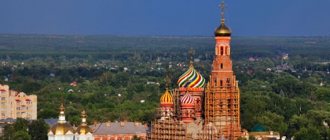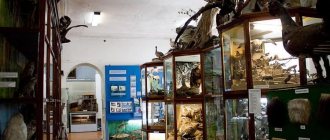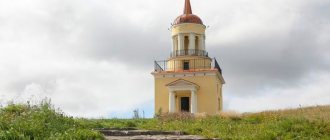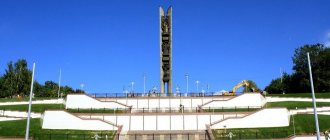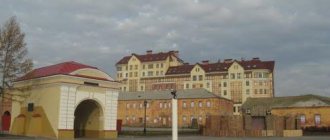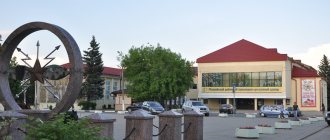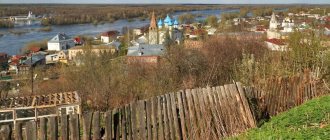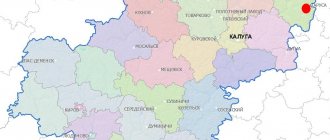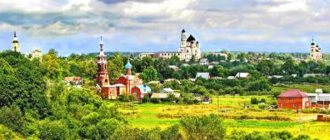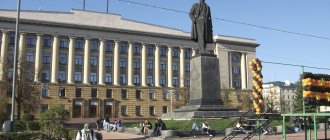The best attractions of Zelenogorsk
Historical information. In the Leningrad region, on the shores of the Gulf of Finland, there is the city of Zelenogorsk. It belongs to the resort area of St. Petersburg.
The history of this settlement has several periods. Already in 1548, some historical sources mentioned the village of Terijoki. This is exactly what Zelenogorsk was called in those days. At that time this territory belonged to Sweden. This territory became part of the Russian Empire in 1721. Already in the Soviet years, in 1918, after the first war with Finland, Terijoki became part of Finland.
In 1939-1940, a second war took place between Finland and the Soviet Union, as a result of which the entire Karelian Isthmus, along with Terijoki, became part of the Soviet Union.
Church of the Kazan Icon of the Mother of God
The Kazan Church in Zelenogorsk is the main operating temple of the city. Its appearance evokes genuine admiration among tourists. The first church was built on this site at the end of the 19th century from wood, but it later burned down. The stone building was erected in 1913. After the Soviet-Finnish war, services in the temple stopped.
It was reopened to parishioners only in 1989. The architecture of the temple fits very well into the local landscape. Its snow-white walls and golden domes look very impressive from the Gulf of Finland. The size of the church is also striking. One and a half thousand people can be inside the building at one time.
Location: Primorskoe highway - 547.
Temples, churches
Zelenogorsk (attractions include temples, cathedrals and churches) is of interest to tourists and pilgrims from all over Russia.
Lutheran Church
The church is included in the register of Russian architectural monuments. Built in 1908. The project was developed and implemented by the Finnish architect Josef Stenbeck. In the fall of 1940, the bell tower of the building was destroyed. During the Great Patriotic War, the USSR government closed the church. A cinema hall was installed in it.
The work of the parish resumed in the spring of 1990. The temple began to be restored and a new bell tower was built. Repair work was carried out in 2000 under the leadership of architect V. Vasiliev. The Lutheran Church opened to believers at the end of 2001. Services are held there daily, and the organ sounds on religious holidays.
Temple of the Kazan Icon of the Mother of God
Zelenogorsk is proud of its Orthodox cathedral and architectural landmark - the Temple of the Kazan Icon of the Mother of God. In 1880, a wooden, carved church stood on this site. But in 1907 it burned down. Construction of a new stone building began in 1910 according to the design of the experienced architect N. Nikonov. The temple was built in 1915 in the Moscow-Yaroslavl style of the 16th century.
After the revolution, the building was subject to floods, tornadoes, and fires. During the Russian-Finnish War the temple was closed. Most of the valuable icons were taken to Finland. In 1943 - 1945 The church was used as a warehouse.
The temple opened for believing citizens in the winter of 1989. The architecture of the building delights and organically complements the urban landscape. The boiling white walls and gilded domes are visible from the coast of the Gulf of Finland. The impressive size of the church can accommodate up to 1600 people at a time.
Temple of St. Seraphim of Sarov
In the fall of 1903, a hall was opened in a small wooden building in which conversations were held and religious lectures were given for the workers of Zelenogorsk. A year later, the place turned into a church, and services began to be held there. According to the plan of the architect I. Sokolov, the building was rebuilt as a temple, adding a dome to it and replacing the wooden walls with stone ones.
In the basement there was a dining room for people in need and a room for activities with children. And the upper part was consecrated in the spring of 1906 in memory of Saint S. Sarov. Three years later, an orphanage was built next to the temple. And they supplemented the temple complex with a side extension - the chapel of the enlightener S. Radonezh.
In 1932 the temple was destroyed. Now there are the remains of the walls of an orphanage. The appearance of the temple remains only in documentary photographs.
Vintage car museum
In 2008, a private museum of retro cars was opened on the territory of Zelenogorsk Park. Its collection includes more than 150 unique exhibits: the cars that Gagarin, Elvis Presley, Marilyn Monroe, Vladimir Vysotsky, etc. drove. The museum also displays samples of old military equipment.
Location: Primorskoe highway - 536.
Museums
The city has interesting and even unusual museums and exhibitions.
Vintage Car Museum
The Museum of Antique Cars is located on the street. Gavannoy, 2. Opened in the fall of 2008 by members of the automobile club. Equipment from the early 20th century is collected here. and later times. The exhibition features 160 cars and motorcycles of different brands, domestic and foreign production. There is a separate exhibition of motor scooters and military vehicles. The exhibitions are constantly updated, changed and expanded.
Visitors can see and photograph the cars of famous people: L. Brezhnev, M. Monroe, Japanese ruler Hirohito, V. Vysotsky, Yu. Gagarin, E. Presley.
Each car is part of the history and development of the automotive industry. The museum is open from 11.00 to 19.00 without breaks and weekends.
Historical and Ethnographic Museum-Reserve Yalkala
The Historical and Ethnographic Museum is located near St. Petersburg, in a dense forest. Yatkala is considered an old museum; its history began back in 1940. At first, the museum’s exhibitions told about the period of the Russian-Finnish war. Then it became a memorial place where V.I. hid during the revolutionary years. Lenin.
After the collapse of the USSR and the rehabilitation of Finnish citizens living on the lands of the Soviet Union, the government created a program to revive the traditions and customs of indigenous local residents. The Yalkala nature reserve appeared. The life of the Finnish settlement is widely represented here, and there is a lot of material about the life of the villagers.
Here you can see:
- national clothes;
- dishes, tools;
- old books, letters, photographs;
- paintings, albums, documents.
A separate hall of the museum is dedicated to the work of the Russian artist and art historian A. N. Benois. Every year, the museum-reserve hosts folk craft fairs, festivals, and holidays. At the end of 2011, a chapel of St. Leonidas was built on the territory of the protected area, where prayers are held for the soldiers who died in the Karelian lands. Museum opening hours: 11.00 – 18.00.
Ant Museum
The museum is located on Lenin Avenue, 12. It is open in the spacious hall of the children's and youth library. The main direction of work of the museum staff is local history. In an interactive form, the children study the history of the city, take online excursions to memorable places in the Leningrad region. They draw a lot, play, and participate in various master classes and quizzes.
Engaged in scientific and research projects. Next to the library building there is a figurine of an intelligent ant with a book. The city government plans to install a dragonfly figurine nearby and complete the composition of the famous fable by I. A. Krylov. The museum is open: from 11.00 to 18.00 – Tuesday-Friday; from 11.00 to 17.00 – Saturday; Day off – Sunday.
Museum of Military Glory
The museum opened in May 1979. Located on the street. Gastello, 19.
More than 2,600 original documents from the Great Patriotic War are collected here:
- military leaflets, maps;
- newspapers “Red Star”, “For Victory”;
- soldiers' diaries;
- notes, notebooks, memoirs;
- weapons, registration cards and belongings of soldiers;
- photographic documents and war newsreels.
Frequent visitors to the museum are schoolchildren, students, and working youth. They are rightfully proud of the exploits and heroism of their great-grandfathers. The museum is available from 11.00 to 18.00 without breaks and weekends.
Museum – estate of I.E. Repina
The museum-estate is located in the village of Repino, a suburb of Zelenogorsk. The museum includes the house of the great painter, a large area of the estate with buildings, a garden and the grave of I. E. Repin. The famous master of painting lived and worked here for a long time. The guides conduct educational walks around the estate and house, talk about the paintings, work, and the last days of the artist’s life.
Unusual things and moments of the excursion:
- round dining table: with rotating center for access to multiple dishes;
- a special palette on the fly: when the master’s right hand failed, he learned to write with his left hand, making an unusual palette for this;
- objects, things: Repin used them for clarity when creating his most famous paintings;
- documentary film: filmed in an estate, shows an old, sick, but not broken, but vigorous and cheerful person;
- access to the artist's studio and visit to his grave.
You are not allowed to take photos or shoot videos in the museum.
The institution is open to the public from 10.00 to 17.00; Closed: Monday, Tuesday.
Don't miss the most popular article in the section: Metro Nizhny Novgorod. Diagram, map, description.
Historical and Ethnographic Museum - Reserve "Yalkala"
The Yalkala Museum was opened in 1940, 12 km away. from Zelenogorsk. Initially, his exhibitions were dedicated to Vladimir Lenin, because. the leader of the world proletariat hid here before the 1917 revolution. Since 1993, the museum has reoriented its exhibitions. And now his collections reflect the life and customs of local peoples and tell about famous personalities who visited these places: Yu. Nikulin, Plekhanov, Benois and others.
Location: Ilyichevo village.
Sights of Zelenogorsk
Station, temples
* Train Station
Located on Vokzalnaya street, 2, just 2 km from the Gulf of Finland.
The first station building was wooden and opened in 1870. In 1917, a new stone building was built. During the war it was heavily damaged and in 1950 it was reconstructed. This reconstructed building still stands today.
* Temples of Zelenogorsk
Church of the Kazan Icon of the Mother of God
Located in Zelenogorsk on Primorskoye Highway.
The first church on this site was built in 1880, but it burned down in 1907.
Construction of the new stone church took place from 1910 to 1915.
In 1939 the temple was closed. It suffered greatly during the Great Patriotic War. It was given back to the parish community again in 1989.
Now this magnificent temple is operational and is classified as an architectural monument of federal significance, protected by the state. The church building was built in the Moscow-Yaroslavl style of the 16th century. Its height is 49 m. The building is white. Very
there are many decorative elements - zakomaras, platbands and cornices, which makes the temple simply luxurious and majestic.
The interior decoration of the temple is very beautiful, especially the multi-tiered iconostasis made of white marble. It is a pity that the columns made of lapis lazuli, rhodonite and malachite that adorned it have been lost.
The temple has such a shrine as the icon of the Kazan Mother of God.
Sculptures of fairy-tale characters are installed on the temple grounds.
* Chapel of the Nativity
Located in Zelenogorsk, on Lenin Avenue.
Before the war, there was a small cemetery wooden church in this place, in honor of the Savior Not Made by Hands. The peasant Mikhail Bogomolov donated money for the construction. The church was destroyed in 1940.
In 2006, a chapel was built and consecrated on this site in honor of the 2000th anniversary of the Nativity of Christ.
* Lutheran Church of the Transfiguration
Located in Zelenogorsk, on Lenin Avenue. This church stands in a very beautiful place and was built in 1908 according to the design of Josef Stenbeck.
Currently under the jurisdiction of the Church of Ingria. In 1940, the church was closed and the bell tower was destroyed. During Soviet times, the church housed a cinema. Between 2001 and 2002, the church was restored and the bell tower was restored.
In 2008, the church was consecrated by the bishop of the Church of Ingria, Arri Kugappi. The church regularly hosts organ concerts and annually hosts the international music festival “Summer in Terijoki.”
The artistic director of music festivals is the Honored Worker of Culture of the Russian Federation - V.A. Shlyapnikov.
Everyone who has heard these concerts notes their high level and the excellent acoustics of the temple.
Protected places
* Historical and ethnographic museum-reserve “Yalkala”
Located in the village of Ilyichevo, not far from Zelenogorsk.
This state museum was opened in 1940, after the end of the Soviet-Finnish war. Initially it was dedicated to the leader of the world proletariat - Vladimir Ilyich Lenin. Here in 1917, in the house of the Finnish family Parviainen, V.I. Lenin went into hiding for some time.
The reorientation of the museum occurred after the collapse of the Soviet Union, in 1993.
It was decided to devote museum exhibitions to the national traditions of the indigenous population of these places. In the museum you can get acquainted with the life of the Finnish village, Finnish culture and way of life, and view the exhibition of the painter A.A. Benoit, who visited Yalkala. You can also see the exhibition dedicated to G.V. Plekhanov and Finnish composer Sulho Ranta. Back in Yankal in 2011, in honor of those killed in the wars, the chapel of St. Leonidas was opened.
The museum reserve itself is located in a very beautiful place, next to the glacial lakes Pitkojärvi (Long) and Kaukjärvi (Bolshoye Simaginskoye), surrounded by relict forests.
* Akhmatova’s country house-booth
Located in the village of Komarovo. In this village on the outskirts of Zelenogorsk, in 1955-1965, the literary foundation built such country houses for writers. One of them was singled out by Akhmatova. That's what she called this house - a booth.
In addition to Akhmatova, Bianchi, the Strugatsky brothers, Joseph Brodsky, Anatoly Naim, Evgeny Rein, Dmitry Bobylev and other writers were engaged in creative work and stayed in this house. Faina Ranevskaya, Alexander Prokofiev, Dmitry Likhachev and Lydia Chukovskaya visited this house. So, the house is well deserved.
The last years of Anna Akhmatova's life were spent in this house. It has become a tradition to hold annual Akhmatov evenings here in honor of the poetess’s birthday. Officially, the house is not a museum, but fans of the poetess’s work love to visit it. Periodically, the hut-house is restored. Sometimes modern writers settle in this house for a while.
* Museum-Estate of I.E. Repin "Penates"
Located on Primorskoye Highway, 411, 15 km from Zelenogorsk. The painter purchased this estate in 1898, where he lived until his death. Then this place bore the Finnish name - Kuokkala. Ilya Repin later remodeled the house in the estate according to his taste and creative plans. The result was an unusual two-story house under a glass roof, with a large number of veranda windows and ceiling light openings. This design of the house provided the artist with a large amount of natural light. Many famous people visited this house at the famous “Repin Wednesdays” - Kuprin, Mayakovsky, Chukovsky, Yesenin, Gorky, Glazunov, Korolenko and others.
Repin lived in this estate for 30 years and was buried there.
In addition to the house, the museum includes a park with gazebos and an artesian well, a garden and the artist’s grave.
Filming is prohibited in the museum.
Museums
* Museum of Retro Cars
Located in the Zelenograd recreation park, on Primorskoye Highway.
This private museum was opened in 2008. The organizers of the museum did their best - more than 150 retro cars are collected there. This alone is an achievement. But the main feature is that among these exhibits there are cars of world famous people - Yuri Gagarin, Vladimir Vysotsky, Leonid Brezhnev, Japanese Emperor Hirohito, Marilyn Monroe, Elvis Presley.
The collection consists of vintage cars that were once produced in different countries of the world. Museum rules allow you to drive and take photographs as a souvenir. A very interesting exhibition is constantly being updated.
* Villa Ainola
Located in Zelenogorsk, on Primorskoye Highway.
This wooden mansion with a park, a platinum and a waterfall is a cultural monument of the early 20th century and is protected by the state.
Before the 1917 revolution, this estate was owned by Aino Granlund, hence the name of the estate. Before him, the house belonged to Nikolai Markovich Salko, the architect of the Ministry of the Imperial Court.
During the Winter War between the USSR and Finland of 1939-1940, this estate was the residence of the head of the people's government of Finland, Otto Kuusinen.
* Ant Museum
This museum was organized at the children's library of Zelenogorsk. Located on Lenin Avenue. At the entrance to the museum there is an interesting monument - “Reading Ant”.
The museum is very interesting for children. Museum staff tell children about the nature of these places and our country in an interesting and playful way. On the basis of this museum, special children's parties for kids are held.
* Monument to Georgy Vitsin
Located in Zelenogorsk, in the recreation and cultural park, on Primorskoye Highway.
The monument, designed by sculptor Yuri Kryakvin, was erected in July 2008. In this way, the townspeople honored the memory (90th anniversary) of their famous fellow countryman - actor Georgy Vitsin.
The monument is a bronze sculpture of Georgy Vitsin in the role of Balzaminov. The weight of the monument is 300 kg, and the height is 2.4 m.
In general, there are many unusual monuments in Zelenogorsk - Raymonda Dien, a monument to reconciliation, a monument to a dachshund, a monument to bread, “dragonfly and ant”, “Tree of Happiness”, “Oude Girl”, “Boots of a Nameless Summer Resident”.
Museum – estate of I.E. Repin "Penates"
15 km. from Zelenogorsk in the village of Kuokkala in 1898, Ilya Repin bought an estate in which he lived until his death in 1930. The two-story house was built according to the drawings of the artist himself, which included a glass roof and many large windows to make it more convenient for Repin to paint his paintings.
Unfortunately, like many estates in the Leningrad region, “Penaty” burned down during the war in 1944. But fortunately, the collection of things was removed from the house in advance. By 1962, the estate was rebuilt. Now she accepts visitors on all days except Monday and Tuesday.
Location: Primorskoe highway - 411.
Akhmatova's country house
Anna Akhmatova’s house, which she herself liked to call “The Booth,” is not, in fact, a museum, but it receives visitors. It belongs to the Literary Fund, which in 1955 gave this house into the possession of the poetess. Here Akhmatova lived until her death.
At one time, Prokofiev, Ranevskaya, Brodsky and other artists came here. The house is periodically restored, and in the summer modern poets like to move into its walls, claiming that this contributes to the rise of creativity.
Location: Komarovo village.
Villa Ainola
Villa Ainola, located at the entrance to Zelenogorsk, is a cultural monument of the early 20th century. It was built in the neoclassical style. And to this day, opposite the facade, the old pond with a dam has been preserved.
During the Soviet-Finnish War, the villa was the personal residence of Otto Kuusinen, the founder of the Finnish Communist Party. After the war, the building was used as a hotel for more than twenty years. Now the villa is under the jurisdiction of the district administration.
Location: Primorskoe highway - 521.
Finnish and Russian souls of Terijoki (now Zelenogorsk)
Zelenogorsk is located in the Kurortny district of St. Petersburg. In the past it was called Terijoki , which means “Tar River” in Finnish. There are beautiful landscapes, a mild climate, fresh sea air, a shallow sea with large sandy beaches and picturesque boulders. At the end of the 19th century, Terijoki became a popular holiday destination. Nowadays Zelenogorsk is a famous resort.
♦ On topic: Gulf of Finland of the Baltic Sea in Zelenogorsk
The shore of the Gulf of Finland in Zelenogorsk
The village of Terijoiki was first mentioned in written sources in 1548. At that time, this territory belonged to Sweden. After the end of the Northern War, it was included in the Vyborg province (then province) of the Russian Empire. The road from St. Petersburg to Vyborg passed through Terijoki. In 1811, these lands as part of the Vyborg province were transferred to the Grand Duchy of Finland.
Primorskoye Highway in Zelenogorsk
The permanent population of the village was only five thousand people, of which approximately 40% were Russians, the rest were mainly Finns. Natural beauty, mild climate, the Gulf of Finland and proximity to St. Petersburg have contributed to Terijoki becoming the largest holiday village on the coast.
Highway in Terijoki, early 20th century (Viertotie Street)
Terijoki in the 1910s
By 1908, there were about 1,400 dachas here, with more than 55 thousand summer residents coming in the summer months. In addition to dachas, fashionable resorts were also built here.
Seaside resort in Terijoki (not preserved). Photos from 1924-1926
Villa "Ainola", 1904. During the Soviet-Finnish War, the Chairman of the Government of the Finnish Democratic Republic, Otto Vilhelmovich (Otto Wille) Kuusinen, lived there. After the war, the Riviera Hotel opened here. Today it is an administrative building. Photos from 1950-1952
Over the years, Admiral S.O. Makarov, L.N. Andreev, V.V. Veresaev, N.G. Garin-Mikhailovsky, M.E. Saltykov-Shchedrin, I.P. Pavlov lived or visited here. D.I.Mendeleev, P.F.Lesgaft, V.E.Meyerhold, A.A.Blok, V.A.Serov, M.Gorky, A.I.Kuprin, A.S.Serafimovich, S.G. Skitalets, K.I. Chukovsky and other famous people of that time.
Beach on the shores of the Gulf of Finland, 1915
Not far from Terijoki, in Kuokkala (now Repino) there was Ilya Repin’s estate “Penates” , where the famous “Repin Wednesdays” were held, where artists, musicians, writers, poets, and scientists gathered.
Estate "Penates" in Repino (formerly Kuokkala)
In 1908, according to the design of the famous Finnish architect Joseph Stenbeck, the Lutheran Church of the Transfiguration of the Lord . Today, Lutheran services are held here, organ concerts are held, and Finnish language courses are held.
Lutheran-Evangelical Church of the Transfiguration of the Lord
Church of the Transfiguration of the Lord in Zelenogorsk today
Interior decoration of the church
Not far from the church in 1910-1914, an Orthodox temple was erected - the Church of the Kazan Icon of the Mother of God .
Terijoki. Church of the Kazan Icon of the Mother of God, photo taken between 1915-1935
Orthodox Church of the Kazan Icon of the Mother of God today
After the October Revolution, Terijoki found itself on the territory of the Republic of Finland. The state border with the USSR passed relatively close to it, along the Sestra River near Sestroretsk . After the winter Soviet-Finnish war of 1939-1940, Terijoki, like the entire Karelian Isthmus, went to the Soviet Union, but in 1941 this territory was reoccupied by the Finns. In 1944, Terijoki finally became Soviet.
Monument to Lenin in Zelenogorsk, behind it is a building built in 1950-1951
In 1946, Terijoki was given city status, and in 1948 it was renamed Zelenogorsk. A sanatorium-resort area was organized on the coast of the Gulf of Finland: new sanatoriums and boarding houses were built, pioneer camps appeared. In 1994, the Zelenogorsk district was included in the Kurortny district of St. Petersburg.
Fountain "Girl Ude", early 1950s
In Zelenogorsk, buildings built before the revolution and during the period of the Finnish Republic have been preserved. Unfortunately, many of them are now in disrepair. There are interesting buildings from the Soviet era. The city is decorated with numerous sculptures and fountains.
Lenin Avenue
The building of the former Public Bank of the Province of Savo-Karjala. Early 20th century
Watch
Monument to French communist Raymonde Diene. Known for protesting the Vietnam War and lying down on the tracks in front of a trainload of weapons in 1950
In recent years, the coastline in Zelenogorsk has been actively developed. There are several beaches here. Some are open for free access, while others are difficult to access.
Zelenogorsk Park of Culture and Leisure. Behind the fence you can see a monument to actor Georgy Vitsin in the role of Balzaminov. Behind the park on the shore of the Gulf of Finland is Golden Beach.
Terijoki-Zelenogorsk has a complicated history. In 2004, next to the Lutheran Church, in memory of those killed in the Soviet-Finnish war of 1939-1940, a Monument of Reconciliation . On it are carved the words from the Gospel of Mark: “Have peace among yourselves.”
Monument to Reconciliation
Behind the monument is the Finnish military cemetery, where 75 Finnish army soldiers who died from 1939 to 1944 are buried.
Burial of Finnish soldiers
Zelenogorsk and the northern coast of the Gulf of Finland in general are a wonderful place to relax. Come to these lands!
Stones
The main attractions of Zelenogorsk on the map:
© Website “On the Roads of the Middle Way”, 2009-2021. Copying and reprinting of any materials and photographs from the site anashina.com in electronic publications and printed publications is prohibited.
Ant Museum
The Ant Muse at the Zelenogorsk children's library is worth a visit for those who spend their leisure time with children. In the museum, in a playful way, children are told about the animal and plant world of the Karelian Isthmus and other Russian regions. By the way, opposite the entrance to the library there is an interesting monument “Reading Ant”.
Location: Lenin Avenue - 12.
Natural complex “Komarovsky Coast”
The natural monument of regional significance “Komarovsky Coast” occupies an area of 160 hectares. on the shore of the Gulf of Finland. It was established in 1992 to preserve local spruce forests. There are several large beaches on the territory of the complex.
Those who like to take a walk and admire the beautiful landscapes will love the low dunes, sea spits and thickets of coniferous trees on the shore. It is convenient to move along the Komarovsky Coast. On its territory there are a large number of all kinds of paths and paths. Rare representatives of flora and fauna complement the interesting appearance of the natural complex.
What to see in 1 day
Zelenogorsk is a small and compact city.
Therefore, in 1 day you can see many attractions:
- Railway station : at first it was wooden, after 1917 a stone building in the romanticist style was erected in its place. The architect of the project is B. Granholm, who built several railway stations in the Leningrad region. During the war, the building was partially destroyed and reconstructed at the end of 1950.
- National Bank Building: a rare and beautiful building of the city. The house was built in Art Nouveau style and has no sharp corners or straight lines. The architect and time of construction of the house are unknown. The bank building was not damaged during the war years and has retained its original appearance.
- Boots of a nameless summer resident : an object of strange shape and design. Huge bronze shoes stand on the alley of the city park. Compass arrows are placed around them. They symbolize the right of a person to independently choose the path of his life. Everyone tries on the boots and takes memorable photographs.
- Spare railway base : created to accommodate old, used trains, locomotives, steam locomotives. You can see pre-war electric trains, diesel locomotives, and diesel trains. A project has been developed for the restoration and revival of some equipment.
- Mansion of I. Novikov : built in 1914. It belonged to the secretary of the province I. I. Novikov. The building became famous after the pro-Soviet puppet government under the leadership of O. V. Kuusinen worked in it in 1939.
- Villa Ainola : beautiful old cottage. Located next to the Gulf of Finland. Built for his family by N.M. Salko, a famous architect from St. Petersburg. The two-story mansion surprises with its elegant design, variety of finishes, and elegant decor. The villa is interesting as a monument of classical architecture.
- International yacht club on the shores of the Gulf of Finland : opened in 1910 by naval admiral N.I. Skrydlov for sailing racing enthusiasts. Today, yachts from many countries moor at the club's pier. The administration of the sports society provides services to vacationers - trips to the sea, club parties, yacht rental, rental of gazebos for events.
- Pike Lake: for lovers of fishing and outdoor recreation. Located near the city. You can conveniently and quickly get to the lake by train or bus. Shchuchye Lake has a clean beach, a site for tents and a parking lot.
- A small house of A. Akhmatova : stands outside the city, in the village of Komarovo. The house is the property of the Literary Fund. Given to the great poetess in the winter of 1955. Akhmatova lived in it the last years of her life. She was visited by I. Brodsky, F. Ranevskaya, A. Lurie, B. Anrep. The house is constantly being renovated; in the summer, young poets and writers live in it.
To enjoy the sights of Zelenogorsk, its views and monuments, it is recommended to come here in the summer. You can get to the suburbs of St. Petersburg by train, shuttle bus or private car. The city is always full of tourists, pilgrims, and travelers. It is famous for its comfortable stay, original architecture and pristine nature.
Article design: Oleg Lozinsky
Nature reserve "Lindulovskaya larch grove"
The beginning of the Lindulova larch grove dates back to the time of Peter I, when the court forester Vogel began planting larches on the banks of the Lindulova River, necessary for the construction of a sailing fleet.
Some of these three-hundred-year-old trees still exist today. Their appearance is truly grandiose. In total, more than 4,000 trees grow on the territory of the reserve. Since 1990 it has been under the protection of UNESCO.
Park of Culture and Recreation
Zelenogorsk Culture and Recreation Park has a rich history. Founded at the end of the 19th century. For many years the park was a center of attraction for the St. Petersburg creative intelligentsia. Unfortunately, many examples of park architecture were lost in the war.
Now the park attracts local residents and guests of the city with an abundance of all kinds of attractions and convenient access to the Gulf of Finland, from which very beautiful views open up. There are many restaurants with excellent cuisine in the park.
Location: Primorskoe highway - 536.
Resort in St. Petersburg: Zelenogorsk, what to see, where to relax, how to get there
A big attraction of the city is the Park of Culture and Recreation (ZPKiO). The entrance to the park is located directly on Primorskoe Highway, opposite the monumental building of school No. 445. It was built in 1951 and many tourists, looking at it, assume that the Municipal Council or other government bodies meet there, the school looks so unusual.
In front of it stands a monument to Lenin. And the school is located on Lenin Avenue - the building is made in the “Stalinist” style, with a wide stone staircase ending in an observation deck, which offers a wonderful view of the park and the Gulf of Finland.
And the main alley of the park leads from Primorskoe Highway directly to the shore of the Gulf of Finland. If you stand facing the Gulf of Finland, on the left there will be a museum of Retro Cars, a mini-zoo "Rainbow" and a wind tunnel, on the right there is a karting track. The park is decorated with numerous sculptures, all of them modern. The Teriok statues were lost.
In June 1989, the Executive Committee of the Leningrad City Council decided to transfer the Kazan Icon of the Mother of God to the believers. The temple, built in 1910-1915, is a federal architectural monument. This is a functioning Orthodox church in Zelenogorsk that you can visit.
For the 100th anniversary of the temple, a multi-tiered iconostasis made of polished white marble was restored according to the original design. The rows of columns that decorated the iconostasis were made of malachite, lapis lazuli and rhodonite.
In 1998, the Lutheran Church, built according to the design of Joseph Stenbeck in 1907-1908, was returned to believers. It is under the jurisdiction of the bishops of the Church of Ingria. In 2001-2002, the church building was completely restored with the reconstruction of the bell tower.
In Zelenogorsk in 2002, a monument to Dachshund appeared. The author of the work is Arsen Avetisyan, the creator of many modern sculptures in the city. In 2003, in Zelenogorsk, at house number 20 on Lenin Avenue, near a bread store, the composition “Bread” was installed. Its author is sculptor Arsen Albertovich Avetisyan. The monument is made in bronze on a granite pedestal. The height of the composition is 40 centimeters. The name of the composition is inscribed on a brass plate attached to the pedestal.
In 2004, a monument to Reconciliation was unveiled near the church, the work of the same sculptor Arsen Avetisyan. In 2008, a monument to Grandmother was erected in the park between houses No. 26 and 28 on Lenin Avenue.
In 2008, a monument to the People’s Artist of the USSR Georgy Vitsin, a native of Zelenogorsk, was unveiled in the city park. The monument was created by sculptor Yuri Kryakvin. It is noteworthy that it was in Zelenogorsk that the beloved actor Georgy Mikhailovich was born. The monument to Vitsin is represented in the image of Balzaminov from the Soviet feature film “The Marriage of Balzaminov,” based on the play by playwright Alexander Ostrovsky.
On the territory of Zelenogorsk Park there is also a unique museum of retro cars “Retro-Union”, which presents a collection of vintage cars from all over the world. Visitors have a unique chance to look at cars of the early and mid-twentieth century, Soviet and foreign production.
Near the children's library, you can see a monument to the Bookworm Ant, and more. The characters of Ivan Krylov’s fable: the hard worker Ant and the Dragonfly, who “sang the red summer,” are one of the newest, most beloved and most visited monuments in Zelenogorsk. The sculptures stand near the children's library as a reminder of the work of everyone's favorite fabulist.
On July 26, 2008, the forged composition “Tree of Happiness” was installed in the “8th of March” park. Anyone can hang their own personal lock on the branches and leaves of the tree, the key to which can also be permanently thrown into the “mouth” of the forester at the base of the “tree.” It is assumed that over time the tree will “grow”, increasing the number of branches and leaves.
In July 2009, the composition “Shoes of an unknown summer resident” was opened in the Zelenogorsk Park of Culture and Recreation (ZPKiO). Interestingly, on the arrow of the monument around the sculptural boots are the names of the largest cities and the distances to them.
At the mass grave of Soviet soldiers in Zelenogorsk, a memorial was erected with a bronze figure of a soldier, similar to the one installed on the mass grave in Komarovo. In the 1970s, the memorial was rebuilt. In 2005, a monument to the residents of Zelenogorsk who participated in the Great Patriotic War was unveiled next to it. In 2010, the memorial was supplemented with an eternal flame.
In Zelenogorsk, a mass grave of soldiers who died during the Great Patriotic War was created in 1985. It can be found on Primorskoe Highway (59th km) - the architectural and artistic concept of the monument is described by the authors as follows:
Slabs of stone mosaics on irrationally placed strict volumes of granite. Their plots are devoid of the usual pomp: the eternal change of seasons, the eternal sleep of the fallen.
In Zelenogorsk, on the continuation of Lenin Street (behind the station), closer to the turn of the road to Roshchino, a “Health Path” appeared. The ancient dachas here are also interesting, including the famous Muzer Dacha on Teatralnaya Street - a large wooden building in which fireplaces and stoves of high artistic value have been preserved.
You can also look at the Ainola villa on Primorskoe Highway - a wooden mansion with a pond, a dam and a waterfall. Previously, Novikov’s mansion on Ispolkomskaya Street was very interesting - a house with a park where the Finnish government was formed during the Finnish War of 1939. Currently in ruins. In the vicinity of the city you can find the ruins of Fort Ino. All these buildings date back to the beginning of the 20th century.
Golden Beach
The local Zelenogorsk beach is one of the largest in the Leningrad region. It has long been chosen as a holiday destination for families with children. And all because there is a very convenient gentle entry into the water and decent infrastructure: umbrellas, sun loungers, changing cabins, children's and sports grounds, several cafes. The local swimming season lasts from late June to mid-August. The water is not very warm: an average of 19.5 degrees . But this is more than compensated for by the clean air filled with pine aromas and yellow fine sand underfoot.
Location: Plyazhevaya street - 5.
General information
The entire Finnish population left this territory, and it began to be populated by citizens of the USSR.
The settlement received city status in 1946, and in 1948 the city received a new name - Zelenogorsk.
Since 1994, the Zelenogorsk district has been classified as a resort area of St. Petersburg.
Interesting Facts
* Translated from Finnish, Terijoki means “Resin River”.
* In 1908, Terijoki was a large holiday village and enjoyed extraordinary popularity. In the summer there were up to 55 thousand summer residents in the village. Among the Teriok summer residents there were many famous people - officials, artists, musicians, poets, writers and scientists.
* At the beginning of the last century, there were resorts for wealthy people in the village.
* During the first revolution of 1905-1907, there were a large number of safe houses of various revolutionary parties in Terijoki.
* Electricity appeared in the village in 1913
* There is no industry in the city of Zelenogorsk - only retail chains and markets.
* The Zelenogorsk region is famous for its mild climate, picturesque nature, healing sea air and shallow sea with beautiful beaches.
Contact Zoo "Rainbow"
Anyone who likes not just to look at animals, but also to communicate more closely with them should visit the small zoo on the territory of the Zelenogorsk Culture and Recreation Park. The local pets are domestic and farm animals: goats, rabbits, chinchillas, peacocks, donkeys, etc.
Zoo inhabitants are allowed to pet and feed carrots, which are given to all visitors upon entry. Kids are simply delighted with such excursions.
Location: Primorskoe highway - 536з.
Komsomolsky Square
Komsomolsky Square in Zelenogorsk was founded in 1950 along with the building of a secondary school. Then it was called “Upper Park”. The school has been preserved and continues to function to this day, as does the square itself.
Since it is located on a hill, an observation deck was built on its territory, from which a majestic view of the Gulf of Finland opens. An additional decoration of the square is the Golden Bowl fountain and the monument to Lenin.
Interesting monuments of Zelenogorsk
Zelenogorsk (the sights are located in the central part of the city) is considered a place of original and rare monuments.
Monument to G. Vitsin
The famous and talented G. M. Vitsin was born in small, unremarkable Zelenogorsk. The monument to the actor was opened in the summer of 2008 to mark the city’s anniversary and the 90th anniversary of the birth of the famous fellow countryman.
Zelenogorsk. The best attractions include the monument to G. Vitsin.
The design of the monument was created by sculptor Yu. Kryakvin. Vitsin meets townspeople and guests of the city in the guise of Balzaminov. He stands in the park, slightly raising his hat, and smiles at passers-by. The sculptor accurately and kindly depicted the actor’s face and facial expressions. Yu. Kryakvin plans to create and place sculptures by E. Morgunov and Yu. Nikulin next to the monument to Vitsin.
Monument to grandmother
In 2008, a monument to my grandmother appeared on the wide V.I. Lenin Avenue in Zelenogorsk. It was erected as a sign of respect, love and gratitude to the elderly population of Russia.
The monument is made in the form of a chair with glasses, knitting needles and a ball of yarn on it. There is no grandmother figure nearby. Therefore, all passers-by can fantasize and imagine their grandmother knitting on a comfortable chair.
Monument to Bread
The bronze monument was unveiled in the summer of 2003 and installed near the bread store. The author of the project is sculptor A. Avetisyan, who decided to immortalize bread. Bread has a special meaning for the residents of St. Petersburg. It will always remind you of the military, hunger blockade.
The front-line and unforgettable daily allowance of 125 g of dark bread is placed in the center of the monument’s composition. Next to the cut bun are crackers, loaf, bagels, bagels. A tiny mouse peeks out from under the dry crust of bread.
Monument to Raymonde Diene
Raymonde Dien is a French woman, a member of the public anti-war movement. The girl's name became known in 1953. A monument to her appeared in the city in 1957. The sculptural composition is dedicated to the feat of the brave heroine. Raymonda did not miss the train with tanks leaving France for Vietnam.
She gathered a group of like-minded people and was one of the first to throw herself under a train. The rest of the women supported her. The train stopped, the girl was arrested, put in prison, and deprived of her civil rights for 15 years. A similar monument to Raymonde Diene was opened in St. Petersburg.
Dachshund sculpture
A monument to a dachshund in the form of a bench was installed on V.I. Lenin Avenue in 2002. The author of the project is local sculptor A. Avetisyan. The Bronze Dog is located in the most crowded place in Zelenogorsk. After the opening of the monument, dog breeders gather near it with their beloved pet dachshunds. They hold competitions and dog parades, communicate, take photographs, and answer children’s questions.
Dachshund owners with their pets from all over Russia come to Zelenogorsk for the city’s birthday. They participate in festive events, hold games and competitions for citizens.
